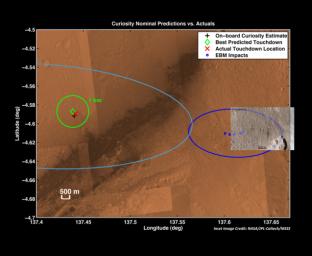
|
Zeroing in on Rover’s Landing Site
- Click the image above for a larger view
- Full-Res JPEG (876 x 718) (72.4 kB)
- Full-Res TIFF (876 x 718) (1.9 MB)
Caption:
The red "X" marks the spot where NASA's Curiosity rover landed on Mars. Early estimates made immediately after the rover landed (green diamond) indicated the rover touched down about one-and-a-half miles (2.4 kilometers) from the point it was targeting, to the left and out of sight on this graphic. This is well within the targeted landing region, called the landing ellipse, marked by the light blue line. Later after landing, images from the High Resolution Imaging Science Experiment (HiRISE) on NASA's Mars Reconnaissance Orbiter (not shown here) were able to pinpoint the rover's precise location, as shown by the red "X."
Before landing, the mission team had also made predictions about where six entry ballast masses released from the descending spacecraft would land, as indicated by the dark blue landing ellipse and six dots. These weights, which are made of a heavy metal called tungsten, were released to straighten the descending spacecraft out from the tilted position it needed to ride through the atmosphere.
The overlaid black-and-white picture shows the actual landing positions of the ballasts, as indicated by the dark scour marks they left on the surface. Arrows indicate the locations. That picture was taken by the Context Camera on Mars Reconnaissance Orbiter.
The background color image is from MRO.
Cataloging Keywords:
| Name | Value | Additional Values |
|---|---|---|
| Target | Mars | |
| System | ||
| Target Type | Planet | |
| Mission | Mars Science Laboratory (MSL) | Mars Reconnaissance Orbiter (MRO) |
| Instrument Host | Curiosity Rover | Mars Reconnaissance Orbiter |
| Host Type | Rover | Orbiter |
| Instrument | ||
| Detector | ||
| Extra Keywords | Atmosphere, Color | |
| Acquisition Date | ||
| Release Date | 2012-08-10 | |
| Date in Caption | ||
| Image Credit | NASA/JPL-Caltech/University of Arizona/MSSS | |
| Source | photojournal.jpl.nasa.gov/catalog/PIA16038 | |
| Identifier | PIA16038 | |
